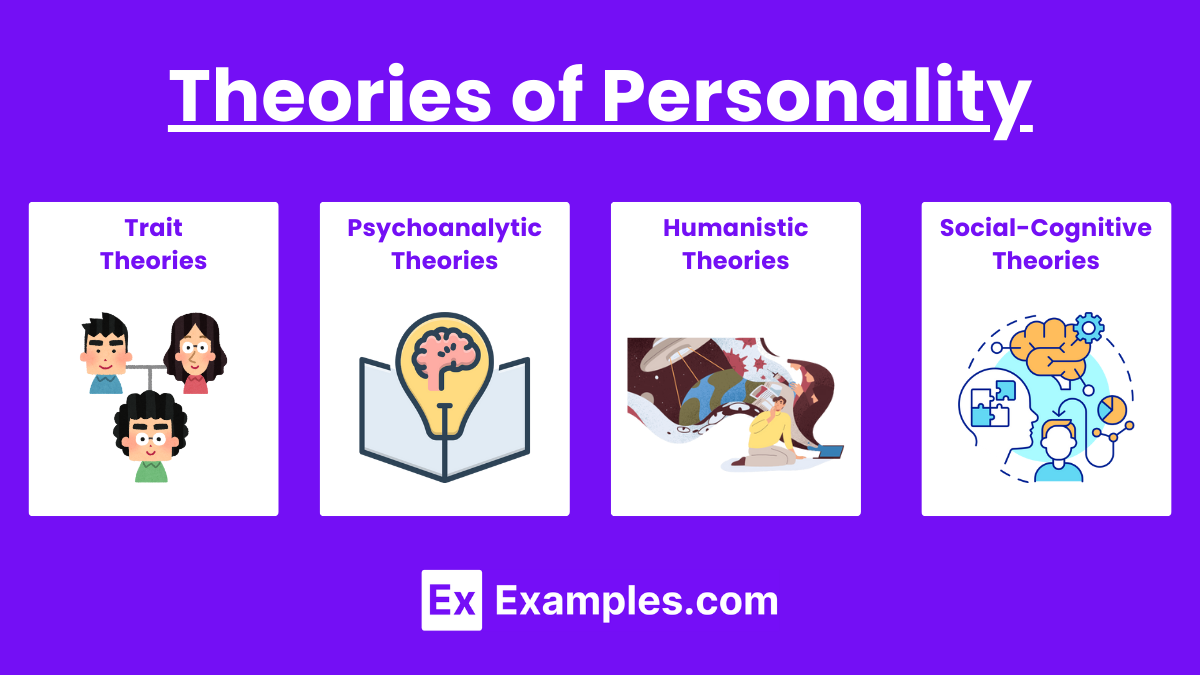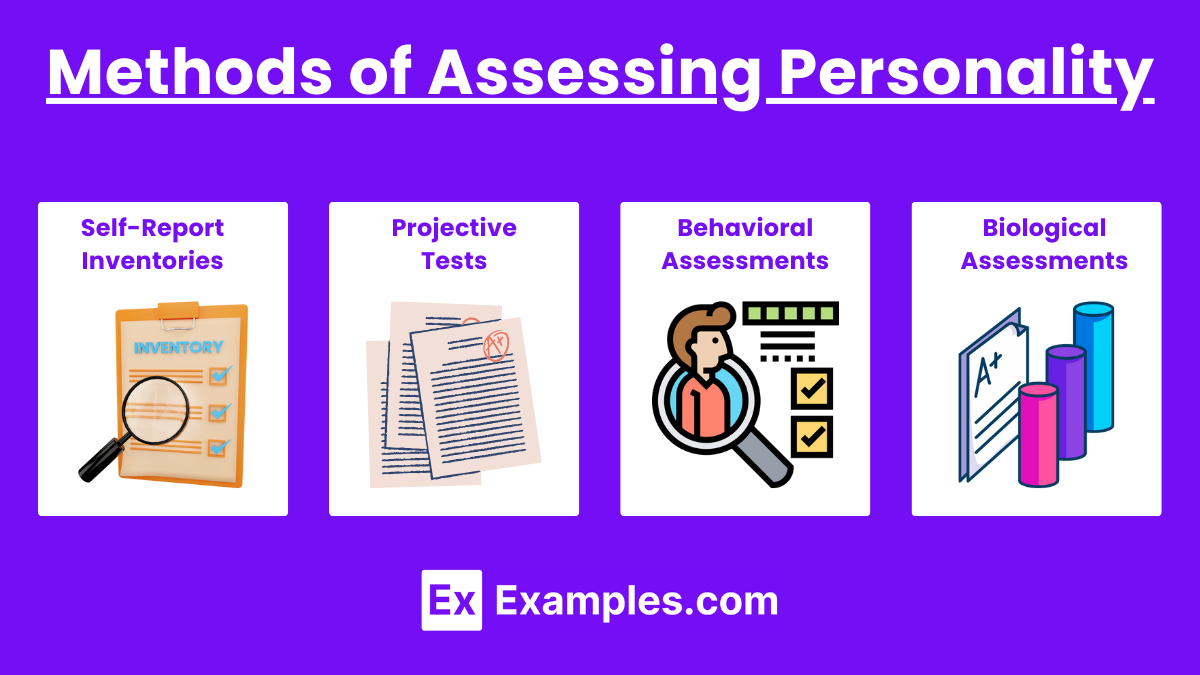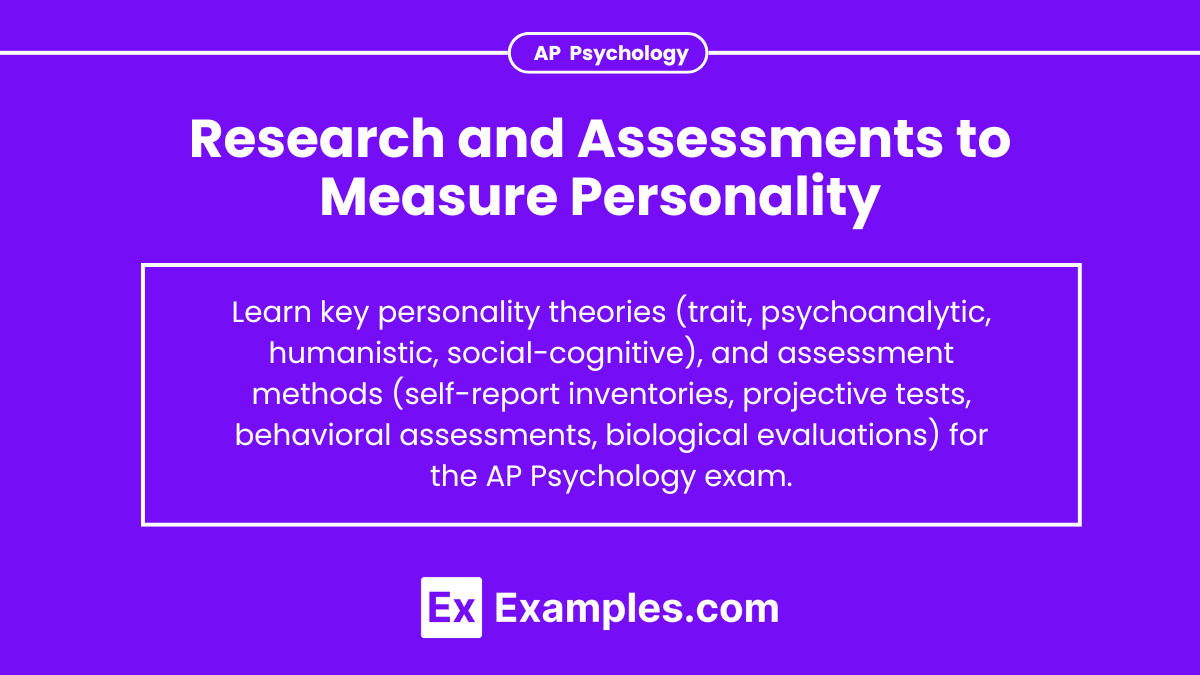Personality research is crucial for understanding individual differences in behavior, thoughts, and emotions. In AP Psychology, students explore various theories and methods used to assess personality, including trait, psychoanalytic, humanistic, and social-cognitive perspectives. Assessments such as self-report inventories, projective tests, behavioral observations, and biological evaluations provide insights into personality traits and patterns. Mastering these concepts and assessment tools is essential for effectively evaluating and understanding personality in psychological studies.
Learning Objectives
Learn the key theories of personality, including trait, psychoanalytic, humanistic, and social-cognitive perspectives. Understand the various methods used to assess personality, such as self-report inventories (e.g., MMPI, NEO-PI-R, MBTI), projective tests (e.g., Rorschach Inkblot Test, TAT), behavioral assessments (e.g., direct observation, rating scales), and biological assessments (e.g., genetic studies, neuroimaging techniques). Focus on the strengths, limitations, and applications of each method to effectively evaluate and measure personality.
Key Concepts in Personality Research
Personality research investigates individual differences in characteristic patterns of Critical Thinking, feeling, and behavior. It encompasses various theoretical approaches, including trait, psychoanalytic, humanistic, and social-cognitive theories, and utilizes multiple methods to assess and understand personality.
Theories of Personality

Trait Theories
Trait theories focus on identifying and measuring individual personality characteristics.
Gordon Allport: Proposed that personality traits are real entities within a person that influence behavior.
Raymond Cattell: Developed the 16 Personality Factor (16PF) model.
Hans Eysenck: Suggested three dimensions of personality (Extraversion, Neuroticism, and Psychoticism).
Psychoanalytic Theories
Psychoanalytic theories emphasize unconscious processes and childhood experiences.
Sigmund Freud: Introduced the id, ego, and superego, and proposed stages of psychosexual development.
Carl Jung: Introduced concepts of the collective unconscious and archetypes.
Alfred Adler: Focused on individual psychology and the inferiority complex.
Humanistic Theories
Humanistic theories emphasize personal growth and self-actualization.
Carl Rogers: Developed the concept of the self and unconditional positive regard.
Abraham Maslow: Proposed the hierarchy of needs and the concept of self-actualization.
Social-Cognitive Theories
Social-cognitive theories focus on the influence of cognitive processes and social contexts.
Albert Bandura: Introduced the concept of self-efficacy and reciprocal determinism.
Julian Rotter: Developed the concept of locus of control.
Methods of Assessing Personality

Self-Report Inventories
Self-report inventories are structured questionnaires where individuals rate themselves on various traits and behaviors. These are widely used due to their ease of administration and scoring.
Examples
Minnesota Multiphasic Personality Inventory (MMPI)
Designed to diagnose psychological disorders.
Contains clinical scales for different psychological conditions.
NEO Personality Inventory (NEO-PI-R)
Measures the Big Five personality traits Openness, Conscientiousness, Extraversion, Agreeableness, Neuroticism.
Provides a comprehensive assessment of personality.
Myers-Briggs Type Indicator (MBTI)
Based on Carl Jung's theories.
Categorizes individuals into 16 personality types based on preferences in four dimensions (Extraversion/Introversion, Sensing/Intuition, Thinking/Feeling, Judging/Perceiving).
Projective Tests
Projective tests involve presenting ambiguous stimuli to individuals, who then describe or interpret them. This method aims to uncover unconscious thoughts and feelings.
Examples
Rorschach Inkblot Test
Individuals describe what they see in a series of inkblots.
Used to uncover unconscious desires and conflicts.
Thematic Apperception Test (TAT)
Individuals create stories about ambiguous scenes.
Reveals underlying motives, concerns, and the way individuals perceive the social world.
Behavioral Assessments
Behavioral assessments involve observing and recording behaviors in specific situations. These assessments can be conducted in naturalistic or controlled environments.
Examples
Direct Observation
Observing behavior in a natural or controlled setting.
Provides real-time data on behavior patterns.
Behavioral Rating Scales
Standardized tools used to rate behavior based on specific criteria.
Examples include the Child Behavior Checklist (CBCL) and the Behavior Assessment System for Children (BASC).
Biological Assessments
Biological assessments examine the physiological and genetic bases of personality. These methods help identify biological underpinnings of personality traits.
Examples
Genetic Studies
Twin and adoption studies assess the heritability of personality traits.
Identify genetic influences on personality.
Neuroimaging Techniques
Functional MRI (fMRI) and PET scans examine brain activity related to personality.
Identify neural correlates of personality traits.


